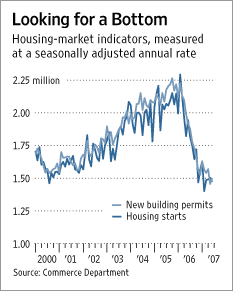From CNN/Money:
More than $1 trillion worth of adjustable rate mortgages (ARMs) will be hit with higher reset rates this year, and that could add up to big trouble for many homeowners.
Already, the rate of serious delinquencies among subprime hybrid ARM borrowers was up to 15.75 percent during the first quarter, from 14.44 percent in the fourth quarter of 2006, according to the Mortgage Bankers Association (MBA).
The end of the housing boom changed the math when it comes to ARMs. Not only are mortgage rates higher, but lower home prices in many markets means borrowers have fewer options than they had before home prices dropped.
…
According to Peter Schiff, founder of Euro Pacific Capital (and a market “bear” of such notoriety, he’s been dubbed “Doctor Doom,”) many of those home buyers based their decisions solely on the affordability of teaser rates – and some even bought knowing they couldn’t afford the teasers.They figured, “All [home prices] had to do was go up 20 percent a year, and I’ll be all right,” Schiff said. If, six months into the loan, they found themselves strapped for cash, they could do a cash-out refinance to make their mortgage payments.
But before these borrowers reach their ARM reset points this year, a whole lot of things have gone wrong.
With the decline in home values over the past year and a half, many borrowers with resetting ARMs will have little or no equity in their homes.
…
The result: increased foreclosures and forced sales, flooding the market with homes and depressing prices even more.“There will be a huge glut of houses that will be coming on to the market,” said Schiff.
…
Schiff, though, takes a characteristically apocalyptic stance on the future. Without the safety valve of home equity to tap, he says, an economy addicted to consumer spending will tank far more severely than anyone else expects. Home prices, he said, will plummet by half or more in some markets.But even if much milder declines occur, some home owners are still in for a tough year.

